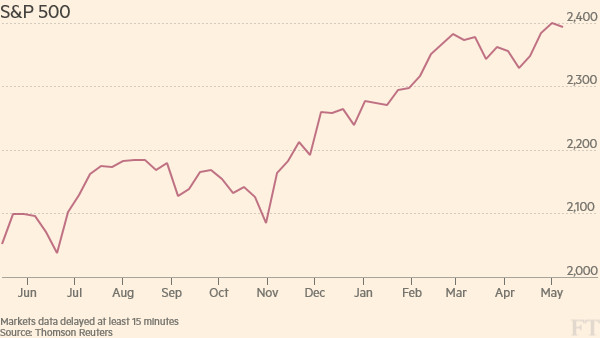Dollar and Treasury yields slide after weaker US data

Simply sign up to the Currencies myFT Digest -- delivered directly to your inbox.
Friday 21:15 BST
What you need to know
● Stock markets struggle for traction as S&P 500 dips but FTSE 100 hits record high
● Dollar and Treasury yields slide sharply after meek US inflation and sales data
● Market slightly less confident of a Fed rate rise for June
● Euro moves back above $1.09 but sterling still sub-$1.29
● Brent crude hovers below $51 while gold gains ground
——————-

Hot topic
The dollar slid into reverse after weak US inflation and retail sales figures surprised traders, prompting the buying of core government bonds and a strong end to the week for gold prices.
The yield on 10-year US Treasuries sank 7 basis points to 2.33 per cent. This biggest decline in a month came after yields reached six-week highs on Thursday, trading above 2.42 per cent thanks to strong US producer price data.
But Friday’s move triggered a chain reaction in other core markets as the 10-year Bund yield fell 3bp to 0.39 while gilt yields dived 7bp to 1.09 per cent, UK sovereign debt outperforming its German peer amid wariness over this week’s poor British industrial data and Brexit uncertainty.
“Friday’s US data looks fairly disappointing, a broader softening nudged the core rate of inflation back below 2 per cent to 1.9 per cent and likewise both headline and core retail sales missed estimates,” said James Smith, of ING Bank. “But today’s sub-consensus US data are unlikely to rock the Fed’s boat, meaning there are increasingly few reasons for not hiking in June.”
Indeed, a four-month high in consumer confidence indicated by a University of Michigan survey released in the wake of Friday’s disappointing figures reinforced consensus expectations that little would deflect the Fed from a likely rate move next month.
“The disappointment in the data does not derail a June rate hike in our view, with the recent further improvement in labour market conditions supporting continued policy normalisation and Fed expectations for a gradual convergence to the 2 per cent inflation target,” said Michael S Hanson of TD Securities.

Although investors were pricing in an 83 per cent chance that the Fed would increase borrowing costs by 25bp in June before Friday’s US data releases, according to the CME’s FedWatch tool, this still stood at 74 per cent afterwards.
Other analysts forecast that the consequences of tightening Fed policy would be felt soon in the Treasuries market, pushing yields higher.
“We still think that the federal funds rate will rise more quickly than investors are anticipating, pushing up Treasury yields in the process,” said John Higgins of Capital Economics.
“We forecast that the 10-year yield will climb from around 2.4 per cent now to a peak of 3.5 per cent next year, shortly before the end of the Fed’s tightening cycle in Q1 2019. Expect this increase in Treasury yields to sap investors’ demand for riskier assets.”

Equities
A mixed performance for global stocks on Friday saw the FTSE All World index gain 0.1 per cent as Europe’s Euro Stoxx 600 climbed 0.3 per cent while the S&P 500 dipped 0.2 per cent by the close of New York trading to 2,390, producing weekly losses of 0.4 per cent.
This left the Wall Street stock barometer around 10 points shy of a record closing high.
US equities have been buoyed of late by signs of improving economic conditions and a well-received corporate earnings season but the S&P 500 has stalled in recent sessions as the 2,400 level looms.
“Many equity market commentators are starting to become concerned about the low level of market volatility, which might be a sign of investor complacency, though EPFR data show that investors are quite aware of the historically high valuations in US equity markets and are switching to better ‘value’ elsewhere,” said VTB Capital’s Neil MacKinnon. “A record $6bn of new capital poured into European equities in the past week.”

Rises for AstraZeneca and a softer pound helped London’s FTSE 100 advance 0.7 per cent to a record closing finish.
Japan’s Topix fell 0.4 per cent, retreating from near one-and-a-half year highs as profit takers emerged. Australia’s S&P/ASX 200 lost 0.7 per cent, but with materials shares proving stoic as commodity prices stabilised.
Hong Kong’s Hang Seng rose 0.1 per cent, while China’s Shanghai Composite advanced 0.7 per cent, bouncing off seven-month lows after Beijing and Washington agreed a trade deal.

Forex and fixed income
The shine was taken off on Friday an otherwise positive week for the dollar — its strongest in five weeks — by FX traders’ reaction to the disappointing US data.
The dollar index dipped 0.4 per cent to 99.20, its worst performance in three weeks. But analysts argued that the underlying bid for the dollar remains resilient and, rather than a reversal, the turn lower may have merely signalled a stall in the rally.
Morgan Stanley’s Hans Redeker said: “Outside of the Fed, global monetary conditions remain easy, contrasting with rising real yields in the US. This should support the dollar, particularly against low yielders and emerging markets.”
The euro was among currencies that gained as the dollar dipped. The single currency climbed 0.6 per cent to $1.0927, supported by data showing German GDP growth accelerated to 0.6 per cent at the start of 2017.
Sterling traded near flat, however, after attempts to test the $1.30 level this week were derailed by poor UK industrial data, and investors were left unimpressed by slightly more hawkish commentary from the Bank of England’s Monetary Policy Committee on Thursday. The pound was fractionally higher at $1.2884 on Friday.

Commodities
Oil prices were eyeing their first three-day winning streak in a month, helped by a report on Wednesday that showed US inventories falling by much more than expected, as Friday’s price action swung between gains and losses.
Brent crude, the international benchmark, edged 0.2 per cent higher to $50.85 a barrel, while West Texas Intermediate, the main US contract, is up 0.1 per cent to $47.89. Both benchmarks have gained nearly 4 per cent this week.
Gold prices finished the week positively, boosted by the weaker dollar, moving 0.2 per cent higher to $1,227 an ounce on Friday after the previous session’s strongest gains in a month.
Additional reporting by Jamie Chisholm in London and Peter Wells in Hong Kong
For market updates and comment follow us on Twitter @FTMarkets
Comments